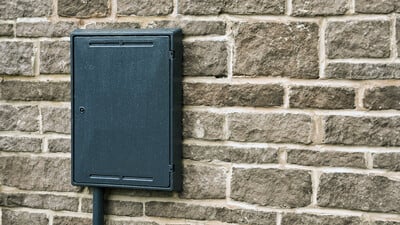In this blog post, we talk about hockey sticks. Not the type seen on the sports field or ice rink, but the plastic version used to connect a building to a main electrical supply.
What is a hockey stick?
An external meter box allows electricity meter readings to be taken without utility employees needing to enter the building, making it safer and quicker for the meter reader and protecting privacy and security inside the building.
Electrical cables are relatively vulnerable, so they must be protected against damage between the point where they rise above ground level and the connection with the bottom of the meter box. As the underground service duct will be laid horizontally but the cable needs to enter the meter box vertically from underneath, the easiest and safest way of making this transition is to use a hockey stick.
Like its sporting namesake, this plastic pipe features a long vertical and shorter horizontal section, with a large-diameter curved segment between them.
If the electrical supply is mounted externally, the vertical section of the hockey stick is attached to the building’s wall with cleats and inserted into the protruding base of the meter box.
An electrical supply can also be run to a meter box within a cavity wall. Using a hockey stick for this type of installation will offer extra protection against accidental damage while drilling through walls, allow easy installation of cables once the cavity is inaccessible, and separate the electrical supply from any cavity wall insulation.
If the supply is run inside the cavity wall, the hockey stick will be connected to the base of the meter box inside the cavity.
The horizontal section is connected to the underground service duct.
What are the advantages of using a hockey stick?
By creating an unbroken transition from horizontal to vertical, the hockey stick’s curve allows for the cable to be easily threaded through the hockey stick and connected to the meter. It also eliminates any joints that might deteriorate over time.
This means that installation is faster and easier, and the cable is given long-term protection against damage and corrosion.
What diameter hockey stick do I need?
Hockey sticks most commonly used for domestic power supplies have a diameter of 32 mm, which is compatible with a standard 37 mm outside-diameter service duct. These are available in white and black.
Larger-diameter hockey sticks are also available for heavier-duty cables such as those used for three-phase electricity. Manufactured in black plastic, these include 38 mm diameter (to fit a 44 mm outside diameter duct) and 50 mm diameter (to fit a 54 mm outside diameter duct).
How is a hockey stick installed?
When connecting a hockey stick to a meter box, there are a few important points to consider:
- The hockey stick must be laid below the minimum excavation depth stipulated by national and local regulations.
- The joint between the hockey stick and the underground service duct must be sealed with suitable plastic-wrapped adhesive tape.
- If the hockey stick is to be run inside a cavity wall, the hockey stick and meter box must both be completely installed during the wall construction phase. Using a hockey stick will facilitate the later insertion and connection of cables.
- Ensure there is a predrilled hole for the hockey stick in the base of the meter box before it is installed.
- The hockey stick must protrude at least 25 mm (1 inch) upwards into the box.
- There must be a minimum of 100 mm clearance between the hockey stick and any other supply cables or pipes serving the property.
Is a hockey stick a legal requirement?
While using a hockey stick isn’t mandatory in all situations, its practicality makes it a sensible option. We recommend you check with relevant, current regulations and legislation before installing an electrical supply without one.
We hope you have found this information helpful and interesting. If you have any further questions you are always welcome to call our friendly team of experts on 01420 555600 or email [email protected].
Also, look out for more articles in our ongoing series of blog posts, bringing you useful information, insights, guides and tips!

Written by
Mark Chambers
Marketing Manager
As Marketing Manager, Mark plays an active role in running strategic projects to increase our brand profile.

